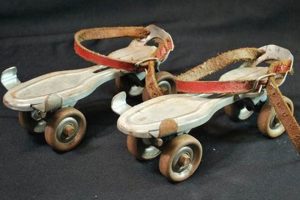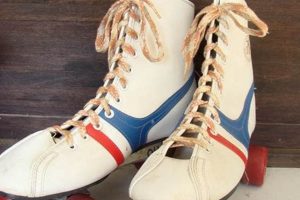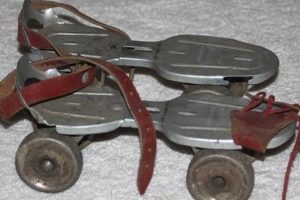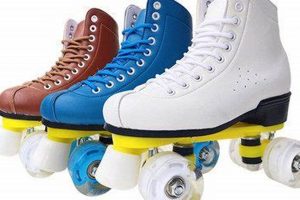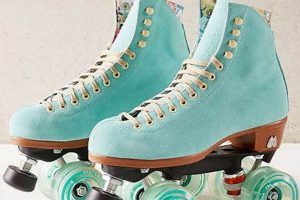These small but critical components are engineered to facilitate smooth rotation between the wheel and the axle of a roller skate. They typically consist of several hardened steel balls or cylindrical rollers encased within inner and outer rings, all held together by a retainer. The function of these elements is to minimize friction, allowing the wheels to spin freely and efficiently. For instance, a set characterized by high precision and quality materials will offer significantly improved performance compared to a lower-grade option.
The significance of these parts extends beyond mere rolling ease; their quality directly impacts speed, control, and overall skating experience. Superior constructions improve energy transfer, enabling skaters to maintain momentum with less effort. Historically, advancements in manufacturing techniques and materials have led to significant improvements in the durability, precision, and performance capabilities of these crucial mechanisms, influencing the evolution of the sport and recreational activity.
The following sections will delve into the specific types available, the ABEC rating system, maintenance procedures to prolong their lifespan, and factors to consider when selecting the optimal set for individual skating needs and preferences. Understanding these aspects is crucial for maximizing enjoyment and performance on roller skates.
Essential Guidance on Roller Skate Bearings
Optimizing the performance of roller skates requires careful consideration and maintenance of these components. The following tips offer practical guidance for ensuring longevity, efficiency, and a superior skating experience.
Tip 1: Prioritize Quality. Invest in sets manufactured from high-grade materials, such as stainless steel or ceramic. Superior materials resist corrosion, reduce friction, and maintain structural integrity under stress, leading to improved performance and durability.
Tip 2: Understand ABEC Ratings. While the ABEC rating system (ranging from 1 to 9) indicates manufacturing tolerances, it is not the sole determinant of quality. Consider the intended use; higher ABEC ratings may be advantageous for speed skating but may not be necessary for recreational use.
Tip 3: Regular Cleaning is Crucial. Dirt, grit, and debris accumulation can significantly impede performance. Implement a routine cleaning schedule, using appropriate solvents and lubricants, to remove contaminants and maintain optimal function. Frequency depends on skating conditions.
Tip 4: Lubrication is Essential. After cleaning, re-lubricate with a lubricant specifically designed for these parts. Thin oils are typically preferred for speed, while thicker greases provide greater protection against wear and corrosion.
Tip 5: Proper Installation is Paramount. Ensure correct seating within the wheel hub to prevent damage or premature wear. Improper installation can create undue stress, compromising performance and lifespan.
Tip 6: Inspect Regularly for Damage. Periodically examine these components for signs of wear, such as pitting, corrosion, or deformation. Promptly replace any parts exhibiting damage to prevent further deterioration and maintain safety.
Tip 7: Storage Considerations. When not in use, store skates in a clean, dry environment to prevent moisture accumulation and corrosion. Consider removing the wheels to alleviate pressure on the internal components during extended storage periods.
By adhering to these guidelines, skaters can maximize the efficiency and lifespan of these crucial components, contributing to a more enjoyable and safer skating experience. Prioritizing quality, maintenance, and proper installation are key to unlocking optimal performance.
The subsequent sections will explore specific product recommendations and delve into advanced maintenance techniques for maximizing the performance and longevity of these vital components.
1. Precision Engineering
The performance characteristics are intrinsically linked to the level of precision employed during their manufacture. Minute variations in the dimensions of the internal componentsthe balls or rollers, the inner and outer races, and the retainercan significantly impact friction, speed, and durability. High-precision manufacturing processes, such as CNC machining and advanced grinding techniques, are therefore essential to minimize tolerances and ensure consistent quality.
Consider the difference between bearings manufactured to an ABEC 1 standard versus those produced to an ABEC 7 or 9 standard. The tighter tolerances specified in the higher ABEC ratings translate directly to smoother rolling, reduced vibration, and improved energy transfer. In practical terms, a skater using high-precision components will experience increased speed and require less effort to maintain momentum. Furthermore, these components are generally more resistant to wear and fatigue, extending their useful life.
Ultimately, the degree of precision engineering directly dictates the performance envelope. While lower-precision components may suffice for casual recreational skating, skaters engaged in competitive disciplines or seeking optimal performance will invariably benefit from the enhanced quality and performance characteristics afforded by components manufactured to exacting standards. The investment in higher precision leads to tangible improvements in speed, control, and longevity.
2. Friction Reduction
Friction, an opposing force to motion, directly impacts the efficiency and performance of roller skates. Minimizing friction within the system is paramount to achieving optimal speed, control, and energy conservation. The components designed for this purpose are integral to realizing these benefits.
- Lubrication’s Role
The introduction of a lubricant, typically oil or grease, between the moving parts within the component reduces direct contact between metallic surfaces. This minimizes friction by replacing solid-on-solid contact with fluid friction, which requires less energy to overcome. The choice of lubricant viscosity and composition is crucial; thinner oils are generally preferred for speed skating to minimize drag, while thicker greases offer greater protection against wear and corrosion in more demanding conditions.
- Material Selection Implications
The materials used in the construction significantly affect friction. Hardened steel is commonly employed for its durability and ability to withstand high loads, but its surface roughness can contribute to friction. The incorporation of materials with inherently lower coefficients of friction, such as ceramic balls or specialized polymer coatings, reduces frictional losses and improves rolling efficiency. For example, hybrid ceramic reduce friction because they are smoother and harder than steel which makes them very useful for increasing speed and reducing maintenance.
- Precision Manufacturing Benefits
Precise manufacturing tolerances are critical for minimizing friction. Irregularities in the surfaces of the balls or rollers and the inner and outer races create points of increased friction and energy loss. Components manufactured to higher ABEC standards exhibit tighter tolerances and smoother surfaces, resulting in reduced friction and improved rolling characteristics.
- Seal Design Impact
Seals are used to protect the internal components from contamination, but they can also contribute to friction if not properly designed. Contact seals, which physically contact the inner race, offer superior protection but generate more friction than non-contact seals. Selecting the appropriate seal design involves balancing the need for protection against contamination with the desire to minimize friction.
In summary, effective friction reduction is a multifaceted engineering challenge that demands careful consideration of lubrication strategies, material selection, manufacturing precision, and seal design. Optimizing these factors results in enhanced performance, increased speed, and a more efficient skating experience. The synergy between these elements is crucial for maximizing the functionality and longevity of roller skates.
3. Material Composition
The material selection in these components critically influences their performance, durability, and suitability for various skating styles. The composition dictates resistance to wear, corrosion, and load-bearing capacity, directly impacting the overall skating experience.
- Steel Alloys
Various steel alloys are commonly employed, each offering distinct properties. Chrome steel (SAE 52100) is frequently used due to its high hardness, wear resistance, and ability to withstand significant loads. Stainless steel variants offer enhanced corrosion resistance, particularly beneficial in wet or humid environments. The specific alloy chosen influences the lifespan and maintenance requirements of the bearings.
- Ceramic Hybrids
Hybrid components incorporate ceramic balls (typically silicon nitride, Si3N4) in conjunction with steel races. Ceramic materials exhibit superior hardness, lower density, and reduced friction compared to steel. This combination results in increased speed, reduced heat generation, and extended lifespan. Hybrid constructions are often favored in high-performance skating applications.
- Full Ceramic
Full ceramic constructions utilize ceramic materials for both the balls and the races. These offer exceptional corrosion resistance and are electrically non-conductive, making them suitable for specialized applications. Full ceramic types are lighter than their steel counterparts, further reducing rotational inertia. However, they are generally more brittle and less tolerant of impact loads compared to steel.
- Retainer Materials
The retainer, which separates and spaces the balls or rollers, is typically constructed from steel, nylon, or other polymers. Steel retainers offer high strength and durability, while nylon retainers provide quieter operation and reduced friction. The choice of retainer material impacts noise levels, friction, and overall bearing performance.
The interplay between these material choices is pivotal in determining the suitability for different skating disciplines. For instance, aggressive skating may benefit from durable steel constructions, while speed skating may prioritize ceramic hybrid or full ceramic types for their reduced friction and enhanced speed capabilities. Understanding the nuances of material composition allows skaters to make informed decisions and optimize their equipment for specific skating needs.
4. ABEC Rating
The Annular Bearing Engineers’ Committee (ABEC) rating is an industry-accepted standard for the dimensional tolerances of bearings. While frequently associated with roller skate bearings, its relevance and application require careful consideration to avoid misconceptions regarding performance expectations.
- Definition and Scope
The ABEC scale ranges from 1 to 9, with higher numbers indicating tighter manufacturing tolerances. These tolerances encompass dimensions such as roundness, sphericity of the balls, and the surface finish of the races. A higher ABEC rating does not inherently guarantee superior speed, durability, or overall performance. It solely signifies a higher degree of precision in manufacturing.
- Relevance to Performance
While tighter tolerances can contribute to smoother rolling and reduced friction, factors such as lubrication, material quality, and bearing design exert a more significant influence on performance. For example, a lower ABEC-rated bearing manufactured from high-quality materials and properly lubricated may outperform a higher ABEC-rated bearing of inferior quality or lacking adequate lubrication. The operating conditions, such as load and speed, also play a critical role in determining the optimal ABEC rating.
- Misconceptions and Marketing
The ABEC rating is often used as a marketing tool, leading consumers to believe that a higher rating automatically translates to superior performance. This is a simplification. Skaters should prioritize material quality, seal type, lubrication, and overall bearing construction over solely relying on the ABEC rating as an indicator of performance. Reputable manufacturers typically provide detailed specifications beyond the ABEC rating to allow for informed decision-making.
- Practical Applications
Different skating disciplines may benefit from different ABEC ratings. Speed skaters, for instance, might opt for higher ABEC ratings to minimize friction and maximize speed. However, aggressive skaters who subject their equipment to significant impact loads may prioritize durability over extremely tight tolerances. In such cases, a lower ABEC rating coupled with robust construction may be more suitable. The optimal ABEC rating is therefore contingent on the specific demands of the skating application.
In conclusion, the ABEC rating provides a measure of manufacturing precision but should not be considered the sole determinant of quality or performance. Skaters should evaluate factors such as material, construction, lubrication, and intended use when selecting roller skate bearings. Understanding the limitations of the ABEC rating allows for a more informed and effective purchasing decision.
5. Maintenance Procedures
Consistent maintenance procedures are essential for preserving the functionality and extending the lifespan of roller skate bearings. Neglecting these procedures can lead to performance degradation, increased wear, and potential safety hazards. Regular attention to cleaning, lubrication, and inspection is critical for optimal operation.
- Cleaning Regimen
Contaminants such as dirt, dust, and moisture accumulate within the bearing housing, increasing friction and accelerating wear. Disassembly, cleaning with a suitable solvent (e.g., mineral spirits or citrus-based degreaser), and thorough drying are necessary to remove these contaminants. Neglecting this step can result in diminished rolling speed and premature failure. For instance, skating in sandy conditions necessitates more frequent cleaning to prevent abrasive damage.
- Lubrication Protocols
Proper lubrication minimizes friction and protects against corrosion. After cleaning, applying a thin layer of appropriate lubricant (e.g., synthetic oil or grease) is crucial. Different lubricants are suited for different skating styles; thinner oils are often preferred for speed, while thicker greases offer better protection for aggressive skating. Insufficient lubrication leads to increased friction, heat generation, and accelerated wear.
- Inspection Intervals
Regular inspection allows for the early detection of wear, corrosion, or damage. Examining the balls, races, and retainer for signs of pitting, discoloration, or deformation is important. Any components exhibiting damage should be replaced promptly to prevent further degradation and maintain safety. For example, a cracked retainer can cause uneven load distribution and subsequent bearing failure.
- Storage Considerations
Proper storage protects against environmental damage. When not in use, roller skates should be stored in a dry, clean environment to prevent moisture accumulation and corrosion. Removing the wheels can alleviate pressure on the internal components during extended storage periods. Neglecting proper storage can lead to rust formation and diminished performance.
Consistent adherence to these maintenance procedures ensures that roller skate bearings operate at their optimal capacity, providing smooth rolling, enhanced speed, and a safer skating experience. Prioritizing maintenance contributes to the longevity of the equipment and reduces the likelihood of unexpected failures. The specific frequency and intensity of these procedures should be adjusted based on skating conditions and frequency of use.
6. Performance Enhancement
The relationship between performance enhancement and the components facilitating wheel rotation in roller skates is direct and consequential. The efficiency with which these components operate dictates a skater’s speed, agility, and energy expenditure. Upgrades or optimization of these parts directly contribute to measurable improvements in skating performance. For instance, a transition from standard steel to ceramic hybrid implementations often results in a noticeable increase in speed and reduced rolling resistance. This enhancement is attributable to the reduced friction coefficient of ceramic materials, allowing for greater energy transfer from the skater’s movements to forward motion.
Furthermore, meticulous maintenance protocols, including regular cleaning and lubrication, are crucial for sustaining peak performance. The accumulation of dirt and debris within these components increases friction, thereby reducing efficiency. By adhering to a consistent maintenance schedule, skaters can mitigate these effects and ensure that these crucial parts operate within their optimal parameters. Consider the example of a competitive speed skater; even marginal improvements in the efficiency of these small components can translate to significant gains over the course of a race, potentially determining the outcome.
In conclusion, the selection, maintenance, and optimization of components are integral to achieving performance enhancement in roller skating. The cause-and-effect relationship between these parts and skating performance is undeniable, and understanding this connection is crucial for skaters seeking to maximize their potential. While advancements in materials and manufacturing techniques continue to drive innovation in this area, the fundamental principles of friction reduction and efficient energy transfer remain paramount.
7. Longevity Assurance
Longevity assurance, in the context of these components, refers to the strategies and practices implemented to maximize their operational lifespan. The service life of these parts is directly correlated with material selection, manufacturing precision, operating conditions, and, critically, maintenance protocols. Premature failure of these components can compromise performance, increase equipment downtime, and potentially pose safety risks to the skater. Therefore, understanding and implementing measures to extend their longevity is of paramount importance. For example, employing stainless steel implementations in coastal environments, where exposure to saltwater accelerates corrosion, demonstrably increases the lifespan compared to standard carbon steel counterparts.
The cause-and-effect relationship between proper maintenance and the prolonged functionality is well-established. Regular cleaning to remove contaminants, followed by appropriate lubrication, mitigates friction and wear. Conversely, neglecting these maintenance steps accelerates degradation, leading to increased rolling resistance, noise, and eventual failure. In competitive skating, where equipment demands are exceptionally high, failure to adhere to rigorous maintenance schedules can result in equipment malfunctions during critical events. Moreover, the financial implications of premature replacement of these components underscore the practical significance of longevity assurance. Consistent maintenance reduces the frequency of replacements, thereby minimizing long-term operating costs.
In summary, longevity assurance is a critical aspect of roller skate operation, directly impacting performance, safety, and overall cost-effectiveness. The combination of appropriate material selection, adherence to recommended maintenance procedures, and conscientious operation are essential for maximizing the lifespan. While advanced materials and manufacturing techniques contribute to inherent durability, proactive maintenance remains the cornerstone of longevity assurance, ensuring sustained performance and minimizing the risk of unexpected equipment failures. The challenges of extending this assurance often lie in balancing the demands of performance with the realities of wear and tear, necessitating informed decision-making regarding component selection and maintenance strategies.
Frequently Asked Questions
The following addresses common inquiries regarding roller skate bearings, their function, maintenance, and selection. The intent is to provide clear, concise information to facilitate informed decision-making.
Question 1: What constitutes an acceptable level of play or movement in a new set?
A minimal amount of lateral play is generally acceptable in new parts, indicating proper seating and alignment. Excessive play, however, may suggest manufacturing defects or improper installation. Components exhibiting excessive play should be inspected and potentially replaced.
Question 2: How frequently should cleaning and lubrication be performed?
Cleaning and lubrication frequency depends on skating conditions. In environments with significant dirt or debris, cleaning should be performed after each skating session. Under cleaner conditions, cleaning every few weeks may suffice. A noticeable decrease in rolling speed is an indicator that cleaning and lubrication are required.
Question 3: Is a higher ABEC rating always preferable?
A higher ABEC rating indicates tighter manufacturing tolerances but does not guarantee superior performance. Factors such as material quality, lubrication, and bearing design are equally important. The optimal ABEC rating depends on the intended use; higher ratings may be beneficial for speed skating but are not always necessary for recreational skating.
Question 4: What type of lubricant is recommended?
The recommended lubricant depends on the skating style and environmental conditions. Thinner oils are generally preferred for speed, minimizing drag and maximizing rolling speed. Thicker greases provide greater protection against wear and corrosion, particularly in aggressive skating applications. Synthetic lubricants often offer superior performance and longevity compared to petroleum-based options.
Question 5: How can one identify counterfeit or substandard products?
Counterfeit parts often exhibit poor machining, inconsistent dimensions, and inferior materials. Purchase components from reputable retailers and inspect for signs of poor quality. Be wary of significantly discounted prices, which may indicate counterfeit products. Comparing the components to known genuine parts can aid in identification.
Question 6: What are the potential consequences of neglecting maintenance?
Neglecting maintenance can lead to reduced rolling speed, increased friction, accelerated wear, corrosion, and potential bearing failure. Worn or damaged components can compromise safety and negatively impact the skating experience. Regular maintenance is essential for preserving performance and extending lifespan.
Understanding these core concepts is crucial for ensuring optimal performance and longevity. Careful consideration of these factors will contribute to a more enjoyable and safer skating experience.
The next section will provide a summary of key considerations for selecting and maintaining these vital components.
Roller Skate Bearings
This discourse has explored the multifaceted nature of roller skate bearings, emphasizing their critical role in skating performance, safety, and equipment longevity. The discussion encompassed material composition, manufacturing precision (as indicated by the ABEC rating), maintenance procedures, and the impact of these factors on rolling efficiency and overall user experience. A nuanced understanding of these elements is essential for informed selection and responsible upkeep.
The long-term functionality and reliability of skating equipment are directly contingent upon the diligent application of the principles outlined herein. Continued advancements in materials science and engineering promise to further refine bearing technology, offering opportunities for enhanced performance and durability. Skaters are encouraged to prioritize informed decision-making, grounded in a comprehensive understanding of bearing characteristics and maintenance requirements, to maximize the potential and lifespan of their equipment. Only through informed practices can the full benefits of these vital components be realized.


